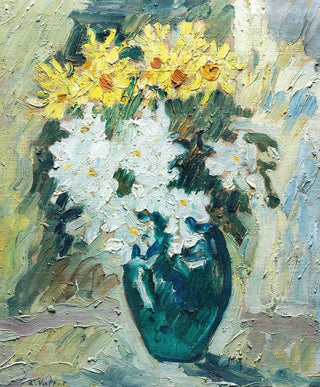Art print | Bouquet - Louis Valtat


View from behind

Frame (optional)
Bouquet - Louis Valtat – Captivating Introduction
In the vast universe of art, certain works stand out for their ability to capture the very essence of fleeting beauty. "Bouquet - Louis Valtat" is one of those creations that, through its delicacy and chromatic richness, invites the viewer to immerse themselves in a vibrant floral world. This painting, a true ode to nature, evokes the freshness of flowers, the lightness of petals, and the magic of colors. Through a harmonious composition, Valtat succeeds in conveying a palpable emotion, transporting the viewer into a secret garden where time seems to stand still.
Style and uniqueness of the work
Louis Valtat's work is characterized by a post-impressionist style that combines boldness and sensitivity. In "Bouquet," the vibrant colors blend with such fluidity that one could almost feel the scent of the flowers. The brushstrokes, both lively and delicate, create a texture that brings the canvas to life. Every nuance, every shadow is carefully crafted to evoke natural light, making this piece a perfect example of the artist's mastery. Valtat, playing with contrasts and harmonies, manages to transform a simple bouquet into a true celebration of life. This painting does not merely depict flowers; it evokes an atmosphere, a sense of fullness and serenity.
The artist and his influence
Louis Valtat, an emblematic figure of the French art scene of the early 20th century, established himself through his unique approach to painting. Influenced by the great masters of Impressionism, Valtat developed a style that is entirely his own, blending tradition and modernity. His ability to capture light and colors inspired many contemporary artists, making him a pioneer in the field of floral painting. Exploring various themes throughout his career, Valtat left an indelible mark on art history, and "Bouquet" is a shining testament to that. This work, while reflecting his talent, also illustrates the evolution of an era where art was liberating itself.

Matte finish

View from behind

Frame (optional)
Bouquet - Louis Valtat – Captivating Introduction
In the vast universe of art, certain works stand out for their ability to capture the very essence of fleeting beauty. "Bouquet - Louis Valtat" is one of those creations that, through its delicacy and chromatic richness, invites the viewer to immerse themselves in a vibrant floral world. This painting, a true ode to nature, evokes the freshness of flowers, the lightness of petals, and the magic of colors. Through a harmonious composition, Valtat succeeds in conveying a palpable emotion, transporting the viewer into a secret garden where time seems to stand still.
Style and uniqueness of the work
Louis Valtat's work is characterized by a post-impressionist style that combines boldness and sensitivity. In "Bouquet," the vibrant colors blend with such fluidity that one could almost feel the scent of the flowers. The brushstrokes, both lively and delicate, create a texture that brings the canvas to life. Every nuance, every shadow is carefully crafted to evoke natural light, making this piece a perfect example of the artist's mastery. Valtat, playing with contrasts and harmonies, manages to transform a simple bouquet into a true celebration of life. This painting does not merely depict flowers; it evokes an atmosphere, a sense of fullness and serenity.
The artist and his influence
Louis Valtat, an emblematic figure of the French art scene of the early 20th century, established himself through his unique approach to painting. Influenced by the great masters of Impressionism, Valtat developed a style that is entirely his own, blending tradition and modernity. His ability to capture light and colors inspired many contemporary artists, making him a pioneer in the field of floral painting. Exploring various themes throughout his career, Valtat left an indelible mark on art history, and "Bouquet" is a shining testament to that. This work, while reflecting his talent, also illustrates the evolution of an era where art was liberating itself.






